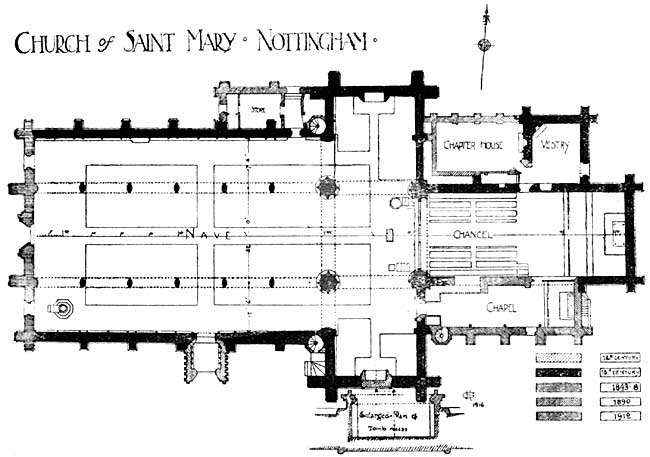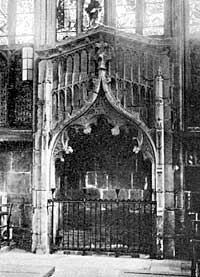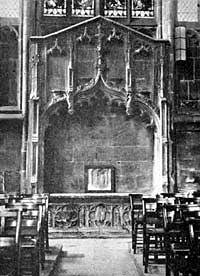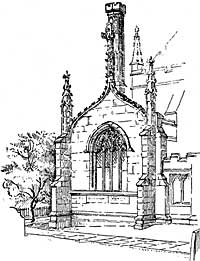
The Chancel.
While this work was being carried on in the church the old chancel remained as before. The joining of the masonry clearly shows that it was rebuilt later than the piers of the tower, but before the settlement of foundations began. The Priory of Lenton was responsible for this part, and probably built it towards the close of the 15th century with far less elaborate detail, though sufficiently spacious in plan to correspond with the rest of the church. The antiquary, John Leland, who visited the church in 1534, described it as "excellente new and unyforme yn worke, and so manie faire windows yn itt that no artificer can imagyne to set more there."
Some incidental references to the operations being carried on may be mentioned here. In 1395, William Leech and Thomas Kay are presented at the municipal court for unjustly occupying the King's highway under the cemetery of St. Mary's with timber to the detriment of all persons passing by.1 In the same year, John Remay, master and keeper of the works at the said church, complains of the theft of a bell-clapper, sold away for 13s. 4d., by Thomas de Downham, clerk, sub-clerk, and keeper of the ornaments of the said church.2 Some work seems to have been going on then at the tower, and the bells were perhaps lying on the ground at the time.
To sum up the story of the rebuilding of St. Mary's, my conclusion is that the work was begun at the close of the 14th century with the transept, porch, and west end, and was carried on, with interruptions, during nearly a century, advancing gradually from the outer walls inwards to the old nave which was kept in use as long as possible and at least till 1450. By the end of the 15th century, the work brought together from the extremities east and west at a slightly different level, was united at a large gargoyle to be seen on the south clerestory; the chancel was added and the church was complete in all its parts. Mr. H. Gill, in an additional paper, will indicate various architectural points of interest illustrating the progress of the work.
Thoroton's view pf St. Mary's church from the north-west in 1667, shows the church as it stood at that date and as it Anally left the builders' hands. Three ogee gables are shown, at the west end, on the north transept where traces are still visible, and on the vestry, which retains this picturesque feature. (Page 61).
The Altars in the Church.
In addition to the high altar in the chancel there would be a row of four altars against the eastern wall of the transept, two under the crossing, and two more west of the rood-screen. The new transept would no doubt have been incorporated with the older church as soon as possible, and would carry on its former dedications. (1) The oldest foundation of a chantry is that of William de Amyas in 1339.3 (2) The gild of All Saints (before 1375), and (3) the gild of The Holy Trinity (1395) must also have had their altars in the earlier church. In 1423, Robert Glade was buried before the chapter of The Holy Trinity on the north. (4) In 1403, Alice Plumtree, wife of John Plumtree, was buried in the chapel of All Saints before the crucifix, (5) In 1431, John Alestre was buried in the chapel of St. John Evangelist, St. John Baptist, and St. Anne, a curious threefold dedication. (6) In 1457, Richard Samon was buried in St. Lawrence, which occupied the end of the south transept; and (7) Thomas Willoughby, in 1525, " before Our Lady Chapel nigh unto his own seat." These testamentary burials are mentioned in the Torre MSS. From the Borough Records we also learn that John Tannesley was buried, 1413, in the chapel of Blessed St. John.
The Tombs.
Most noticeable are the two canopied tombs at the ends of the north and south transepts. They are important links in the elusive chain of evidence for the gradual rebuilding of the church.

Tomb in south transept.
The canopy in the south transept, with its finely foliated and feathered arch beneath an ogee backed by a panelled gable, shows an exact correspondence with the external arch of the south porch. It has been constructed in the end wall of the transept and is contemporaneous with the building of the lower stage of the wall. Whatever tomb existed beneath the canopy has been destroyed, but on the floor there now lies an alabaster effigy of a civilian in long cassock with gown buttoned down the front, with anelace or short dagger slung by a baldrick over the right shoulder, a tall round cap and a pointed beard. His head rests on a pillow once supported by figures of angels, and a dog lies at his feet. The figure is of the early part of the 15th century; whether it really belongs to this canopy cannot absolutely be decided, as neither Thoroton nor subsequent writers mention it. But we may accept the supposition of Mr. W. Stevenson that it represents John Samon, and that this canopied tomb is the one recorded by Thoroton as bearing the inscription, Orate pro anima Johannis Samon et Agnetis uxoris ejus "in the south aisle." John Samon or Salmon, "benefactor of this church," died September 29th, 1395, about the time of the commencement of the rebuilding, and his wife Agnes some years later. His grandson, Richard Samon, junior, died 1427, as recorded on a broken floor-slab lying near the north-west door. It has a cross with a shield on the stem bearing the Samon arms: argent, a bend azure between a mullet pierced and an annulet gules. Richard, the son of John Samon, died in 1457. He was Mayor six times, and was buried in St. Lawrence chapel, which probably occupied the end of the south transept and was the burying place of the family.

Tomb in north transept.
In the end wall of the north transept, another handsome ogee canopy flanked by buttresses and having four brackets for images, and the Tudor roses in the spandrils, occupies a similar position beneath the large window. In this case, however, the tomb was added after the wall had been built at least as high as the window-cill, for the central mullion and cill have been cut away to receive it. Beneath the canopy is an alabaster tomb surmounted by a Purbeck marble slab, but neither tomb nor slab belongs to the canopy. Both have been thrust beneath the canopy which has been cut to receive them, so that the ends of the tomb are hidden, It is doubtful whether the black marble slab belongs to the tomb it now covers. It bears the matrices of a large brass with two figures under crocketted ogee canopies. The front edge has been cut off, and the back edge as well, for it seems to have been originally wider than at present. The shape of the shields and the canopies indicates an earlier date than that of the alabaster tomb which the slab covers, though it fits its length so well that it appears to belong to the tomb.
The alabaster tomb, though mutilated and partly concealed by the sides of the arch into which it has been crammed, is of great beauty and interest, and in date is not later than the early years of the 15th century. In front are three quatrefoils enclosing blank shields, spaced with four narrow panels, containing figures, and at each end a similar figure panel is still visible. Beginning at the west end, the six subjects of the panels are: a symbolical representation of the Holy Trinity much defaced; the Blessed Virgin with a dove over her left shoulder; a lily pot with the unusual feature of a crucifix on the lily-stem; the Angel Gabriel; St. John Baptist; a female saint with perhaps a palm branch in her hand. Three of the dedications of altars in the church are thus represented. Here again we have no direct evidence of the names of those to whom the slab, the alabaster tomb, and the canopy which is the latest of the three, were originally erected. Possible claimants are John Tannesley, who was buried according to his will (1413) in the chapel of the Blessed St. John: he was father-in-law to John Samon, and left £10 to the fabric; John Alestre, buried 1431 within the same chapel, probably at too late a date for the alabaster work. But Mr. W. Stevenson's suggestion of Thomas Thurland may most safely be accepted for the canopied tomb. He died 1474, having been nine times mayor, and four times member of Parliament. Leland, in 1534, speaks of Thomas Thurland and Robert Englyshe, mayors and rich merchants of Nottingham, as buried in the church; and an unknown visitor in 1634 mentions "twofaire monuments, one of which was Samon's, the other Thurland's."
The chapel of All Saints in the north transept was confirmed to the family of Plumtree in 1633 for a burial place, and since that time the transept has been known as the Plumtree aisle. The monuments seem to have been tidily packed away one behind the other, and the nameless tombs gradually become accredited to Plumtrees. The plate given of the tomb in Throsby's history shows it in its present state, but with the Plumtree arms and an inscription "to his ancestors" added to it by Richard Plumtree, who probably defrayed the cost of the plate in Throsby's book (1786).
Deering, in 1751, mentions, and Throsby gives an illustration of another alabaster tomb with figures holding shields on one side of it, surmounted by an effigy of a civilian, which is probably the battered relic now to be seen lying in the north aisle. A fragment of the alabaster tomb now lies loose under the north canopy. It may have been the tomb of John Tannesley or Robert English. Two other noticeable floor-stones are lying near the west door. One undated bears the arms of Strelley impaling the Clifford or Pierrepont lion, inscribed "Ann the wife of Nicholas Strelley." The other is a large marble slab, 9ft. 8in. by 4ft. 5in., showing plugs for a brass.
Other Fragmentary Remains.
A few quarries of old glass may be seen on the west side of the north transept; and some 14th century floor-tiles in the pavement near the lectern.
A small pectoral cross, such as may have been worn by a bishop, was found in one of the stone coffins now lying outside the east end of the church, and is preserved in the vestry.
The font is not ancient, but stands on an old base.4 Round the bowl is inscribed in very modern Greek capitals a palindrome of the Emperor Theodosius from St. Sophia at Constantinople, reading either backwards or forwards :
![]()
Wash sins not face only.
An alabaster figure panel, found beneath the choir stalls, is preserved under glass in the new south aisle of the chancel, and has for us a special interest inasmuch as Nottingham was a centre of the alabaster carving trade. The larger works were produced at the actual quarries, such as those at Chellaston, co. Derby, but the smaller panels such as this one, which were in great demand in the 14th and 15th centuries, were the work of Nottingham artists. The panel represents a Pope attended by two cardinals, receiving in audience an Archbishop, who kneels before him placing his clasped hands in the Pope's left hand. The Archbishop is attended by his chaplain who bears his cross-staff, and three others in the background. Traces of colour and gilding may still be detected on the panel, which no doubt formed part of a reredos for one of the altars. The panel measures 22in. x 13in.
It has been suggested to me by Dr. P. Nelson, F.R.S., that the subject of the panel might be the visit of St. William of York to Pope Eugenius III., who deprived him of his position in 1147, and restored him in 1153, shortly before the death of the Archbishop, caused, so it is stated, by poison in the chalice. It is possible that William de Amyas (1339) may have included his name-saint in the dedication of his chantry, though the panel is of the last quarter of the 14th century. More probably, however, as Dr. Nelson agrees, the alabaster panel represents the story of St. Thomas Becket of Canterbury resigning his archiepiscopal cross-staff and ring to Pope Alexander III., at Sens, in 1164, and entreating him to appoint a more worthy successor. The Pope accepted the resignation but immediately reinstated Becket in the See of Canterbury. This is perhaps the precise incident represented on the panel.
In 1436, Alice Tannesley claimed 3s. 4d. for a breach of covenant from Richard Marsh, a Lincolnshire painter of images, who had undertaken to make unam clausuram pro una tabula, a case for a panel, at the altar of St. John, in St. Mary's church.5 This may have been one of the alabaster St. John Baptist's heads which seem to have been a speciality of the Nottingham workers. A specimen in its original oak case, from the Leicester Museum, was exhibited by Mr. W. St. John Hope, at the Nottingham meeting of the Archaeological Institute.
One of the treasures of the church is a painting of the Virgin and Child, by Fra Bartolomeo (1459-1513), now hanging on the south east tower pier. It was presented by Mr. Thomas Wright in 1831, but in 1842 was discovered rolled up and stowed away in the vestry.
Later alterations.

North side of vestry.
Alterations and repairs have very considerably deprived us of much evidence of the original work. I will briefly mention them in chronological order.
(1725) The west end was rebuilt in classical style with a heavy pediment surmounted by an urn. A new roof was placed upon the nave, entailing the destruction of the clerestory tracery.
(1761) The south aisle was re-faced with Derbyshire stone, the porch alone being left. This was repaired in moulded Roman cement which has now crumbled off.
(1820) Mr. William Stretton, churchwarden and architect, rebuilt a good deal of the south transept end wall, and vaulted the crossing under the tower with wood and plaster from the original springers. A few years earlier an unsightly ringers' loft, in full view of the church, had been removed.
(1839) Many alterations were made in the internal arrangements under Archdeacon Wilkins. The mutilated effigy now in the north aisle, and perhaps the other tombs, were turned out; the chancel completely shut off by a 9in. brick wall with the altar placed in front of it; an organ erected in a gallery at the west end. His successor removed this brick screen, and cut off the west end by bringing the western gallery half-way up the nave.
(1843) A proposal to demolish the whole building on account of its dilapidated state was only just defeated. The church was closed for five years, during which the west front was rebuilt by Sir Gilbert Scott, in accordance with Thoroton's picture of the original. The nave-roof and clerestory windows were renewed, and the two western pillars were rebuilt. The tower-piers were rebuilt or renewed. The chancel was re-roofed and repaired at the charge of the patron, Earl Manvers, by another architect, who removed the oak stalls, which were bought by Mr. Wilcockson to save them from destruction, and subsequently placed in St. Stephen's church, Sneinton.
(1867) Under Canon Morse, the galleries and high pews were removed, and the aisles and transepts re-roofed (1872). Sir Gilbert Scott's stalls placed in the chancel.
(1885) Bodley and Garner erected screen and reredos.
(1905) The bronze doors placed in south porch, in memory of Canon J. F. Morse, Vicar, 1864-1886.
(1915) The fine addition of south chancel aisle for the reception of the organ was made by Mr. Temple Moore, architect.
The "Bells of St. Mary's" was the subject of a paper in the Thoroton Society Transactions, Vol. XIX., by Mr. J. Bramley.
I have to acknowledge indebtedness to Rev. J. C. F. Hood's "Account of St. Mary's Church, Nottingham," 1910, in which may be found also a list of vicars, and an account of the modern glass.
(1) Borough Records, Vol. I., page 276.
(2) Ibid., page 262.
(3) Borough Records, vol. I.
(4) Font was illustrated in Simpson's series on ancient baptismal fonts, 1828.
(5) Borough Records, vol. IX., p. 154.
